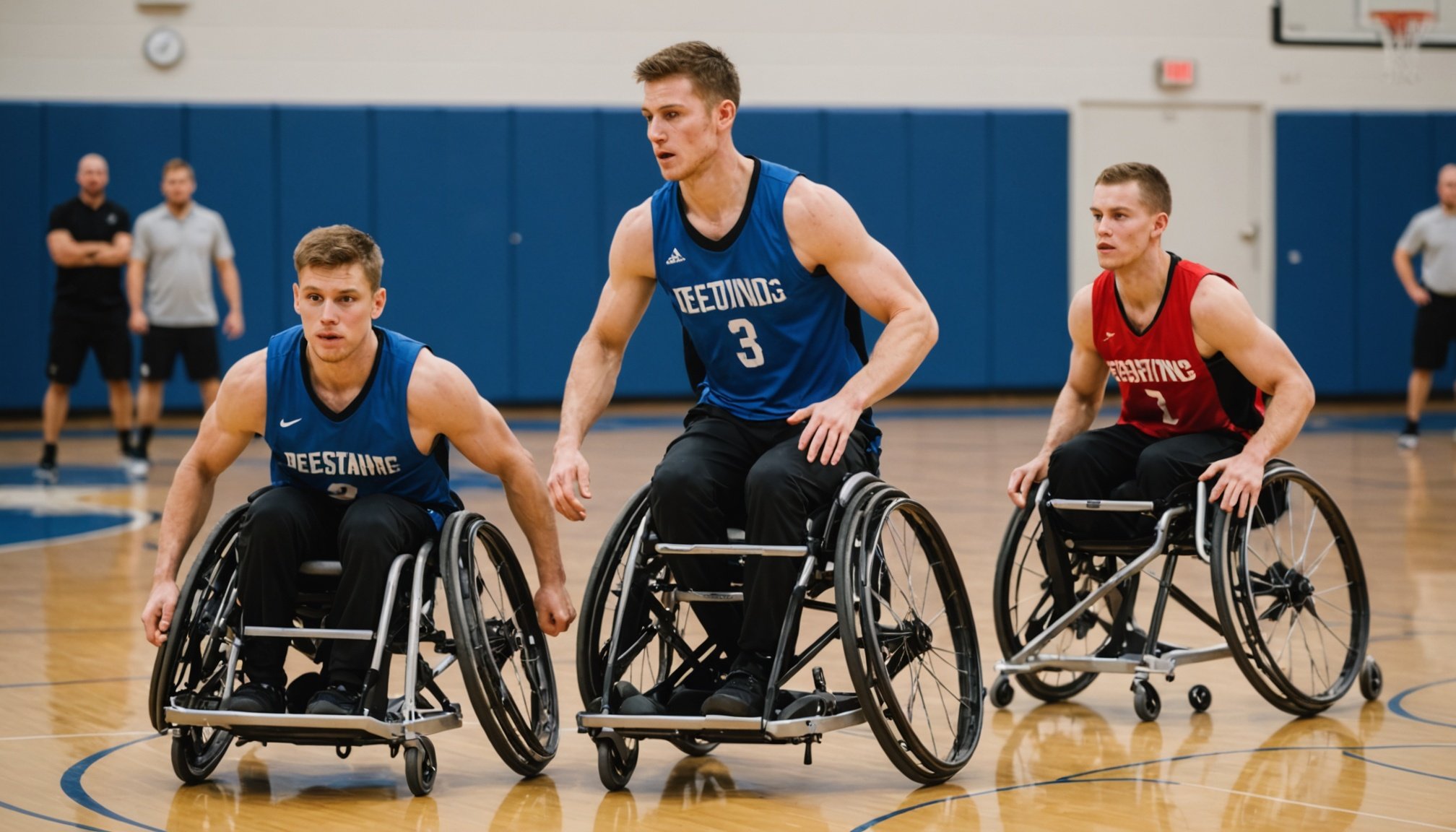Understanding the Needs of Adaptive Wheelchair Basketball Athletes
Adaptive wheelchair basketball demands a unique approach to addressing the performance enhancement of athletes. These adaptive athletes must navigate the sport’s competitive nature, balancing both physical demands and adaptive challenges. It’s not just about participation but excelling at a high level.
Adaptive athletes encounter physical considerations that necessitate tailored support. Engaging in wheelchair basketball requires upper body strength, agility, and coordination. Common challenges arise from prolonged wheelchair use, leading to potential overuse injuries and asymmetrical muscle development, which impacts their performance enhancement.
Topic to read : Elevate your combat sports game: harnessing neurocognitive training to enhance reflexes
To meet these needs, tailored strength and conditioning programs are pivotal. Such programs should focus on boosting performance enhancement by addressing the unique physical demands of adaptive athletes. Strengthening the upper body, enhancing core stability, and ensuring flexibility can significantly improve performance while reducing injury risks.
Moreover, these programs must evolve alongside the athlete’s progression, ensuring they remain individualized and responsive. Coaches and trainers should perform regular assessments to identify the specific performance enhancement needs of each athlete, adapting exercises to optimise their training potential. Creating a supportive training environment that recognises these factors will not only bolster performance in wheelchair basketball but also empower adaptive athletes to achieve their fullest potential.
In parallel : Essential strategies for successful psychological debriefing post high-pressure equestrian events
Principles of Program Design for Adaptive Athletes
Creating an effective program design for adaptive athletes involves understanding the core principles of strength and conditioning tailored to their needs. At the heart of this approach is an individualized assessment of each athlete. This assessment is crucial for determining specific strengths, weaknesses, and limitations, ensuring that every athlete’s program is uniquely tailor-made.
To optimise program design, integration of sport-specific skills into training is essential. Adaptive sports, such as wheelchair basketball, demand skills that transcend general athletic prowess. Thus, incorporating drills that mimic game conditions can enhance the athlete’s performance significantly. These drills are not only about physical conditioning but also about improving strategic understanding and decision-making during the game.
An important element in this setup is the strength and conditioning regime, which should align with sport-specific demands. Core exercises, flexibility routines, and agility drills should be meticulously embedded into the training framework. Regular reassessment of the athlete ensures the program evolves with their development, maintaining relevance and effectiveness. By intelligently adapting these programs, coaches can maximise performance outcomes and empower athletes to push their boundaries.
Key Exercises for Strength and Conditioning
Adaptive wheelchair basketball athletes require a diverse array of strength exercises and conditioning routines tailored to their unique physical demands. At the forefront of this regimen are exercises that foster upper body strength development. These include pushing movements such as seated rows and bench presses which are crucial for enhancing pushing capabilities and maintaining performance enhancement.
Upper Body Strength Development
Developing upper body strength is vital for adaptive athletes, as it directly impacts the ability to maneuver the wheelchair efficiently. Targeted exercises like lat pull-downs and resistance band routines are recommended for athletes to build the necessary robustness and stamina.
Core Stability and Functionality
Core stability not only aids in performance enhancement but also ensures proper posture and balance. Adaptive athletes can benefit from exercises like seated Russian twists and planks. These activities enhance core strength, contributing to a more stable performance during competitive play.
Lower Body Adaptations
Although wheelchair basketball predominantly involves the upper body, tailored adaptive movements focusing on the lower body are essential too. Exercises such as seated leg lifts or resistance band abductions help maintain muscle tone and prevent imbalances, providing a well-rounded conditioning routine that supports overall athletic performance.
Progressions and Adaptations in Training
In adaptive wheelchair basketball, leveraging exercise progressions and adaptations is crucial to meeting sport-specific challenges and capabilities. As adaptive athletes increase in strength and skill, gradually progressing their training is essential to maintain engagement and performance enhancement.
Techniques for Progressions
To effectively progress, start by building a strong foundation with basic exercises. Once mastered, increase the complexity by adding resistance, altering movement tempo, or integrating balance challenges. These gradual increments prevent plateaus and keep strength gains consistent.
Modifications for Exercises
Understanding each athlete’s specific needs allows for suitable modifications to accommodate any limitations. For instance, resistance bands can replace weights for those with joint concerns, while seated adaptations of traditional exercises support diverse mobility requirements. These adjustments ensure safe, effective training tailored to each individual’s ability.
Assessing Readiness
Continuous assessment is integral in recognising when an athlete is ready to progress. Evaluations should include performance metrics and movement quality insights to guide training adjustments. An athlete’s readiness for progression is determined not just by their physical capability but also by consistent performance in existing routines.
By prioritising these methods, coaches can design dynamic, responsive programs that empower adaptive athletes to reach new performance heights effectively.
Training Frequency and Periodization
Creating an effective training frequency and periodization framework is crucial for adaptive wheelchair basketball athletes, helping them achieve peak performance while managing fatigue and avoiding burnout.
Training Frequency
For optimal performance enhancement, adaptive athletes should engage in a workout schedule incorporating frequent short sessions rather than sporadic, lengthy workouts. Ideally, athletes aim for at least three to four focused training days per week. These sessions should alternate between strength exercises and conditioning, allowing for adequate recovery, critical for muscular and neural adaptation.
Periodization Principles
Periodization involves strategically organizing training phases over time to improve performance. It typically includes cycles of varying intensity and volume to ensure progression and recovery. Key to adaptive sports, this method includes adjusting training volume based on the athlete’s competition schedule and physical performance metrics. Balancing training frequency with phases of high and low intensity helps maintain peak condition and prepare athletes for competitive events.
Balancing Training Components
A well-rounded workout schedule effectively balances strength, conditioning, and skill training. Integrating skills relevant to gameplay within physical training sessions enhances the strategic understanding of wheelchair basketball. Meanwhile, flexibility and rest days are essential components, safeguarding against overuse and promoting long-term athlete development. These structured approaches lay the foundation for sustained performance enhancement.
Case Studies and Success Stories
Showcasing case studies from adaptive wheelchair basketball underscores the effectiveness of tailored training programs. In one notable case, an athlete utilised a personalised strength and conditioning regime, significantly improving their on-court agility and upper body strength. This athlete’s story highlights the impact of a structured program on performance outcomes.
Another success story features an athlete who integrated sport-specific drills into their training, leading to enhanced strategic gameplay skills. By focusing on exercises such as seated rows and resistance band routines, they achieved notable improvements in arm speed and wheelchair handling, essential for competitive play.
Lessons from these athlete successes reveal the importance of continuous assessment and program adjustments. Tailoring exercises to the needs of each athlete, as demonstrated, encourages not only physical enhancement but also psychological resilience. It’s about setting achievable goals and progressively building on them to push boundaries, maintain motivation, and ultimately, achieve success.
These performance outcomes advocate for a supportive training environment, bolstering athletes’ confidence and skill set. Coaches and trainers should leverage these experiences to refine their approaches continuously, empowering other adaptive athletes to reach their full potential in wheelchair basketball.
Injury Prevention Strategies
Adaptive wheelchair basketball athletes face unique challenges, making injury prevention a crucial aspect of their training regimen. Common injuries often involve the upper body, including shoulder strain from repetitive motions and stress fractures due to impact and overuse. Understanding these causes is the first step in implementing effective safety protocols.
Incorporating comprehensive safety protocols into regular training can drastically reduce injury risk. This includes structured warm-up routines, focusing on gradual muscle activation and mobility exercises to prepare the body adequately. Additionally, employing resistance band conditioning and flexibility exercises can help maintain muscular balance and joint stability, further aiding in risk management.
Beyond physical training, the importance of recovery should not be overlooked. Cross-training not only provides a mental break but also allows the body ample time to recuperate from the specific demands of wheelchair basketball. Including activities such as swimming or hand cycling can promote cardiovascular fitness while alleviating stress on frequently used muscles.
Furthermore, regular assessments and adjustments to an athlete’s training plan are essential. By identifying and addressing emerging vulnerabilities early, coaches can modify programs to better suit an athlete’s evolving needs, ensuring both performance enhancement and effective risk management.
Visual Aids and Resources
Visual aids and instructional materials play a crucial role in enhancing the training experience for adaptive athletes in wheelchair basketball. They serve as essential tools to facilitate understanding and proper execution of exercises.
Charts for Exercise Selection
Developing exercise selection charts provides athletes with a quick-reference guide to tailor their training routines effectively. These charts should categorise exercises by focus area, such as upper body or core, and include visual representations to ensure correct form and execution. Comprehensive coding, combining graphical elements with written instructions, enhances accessibility for all learning styles.
Video Demonstrations of Techniques
Access to video demonstrations is invaluable for adaptive athletes. These videos offer step-by-step guidance on exercises like resistance band work and agility drills, ensuring safe and proper technique. Visual demonstrations help athletes grasp complex movements more easily and reduce the risk of injury through imitation of correct postures and repetitions.
Recommended Reading and Online Resources
To broaden their knowledge base, athletes and coaches should engage with a wide array of recommended reading and online resources. Books and articles detailing adaptive sport science, coaching strategies, and athlete wellness provide depth and context to training regimes. Leveraging curated content from reputable sources can support ongoing learning and development in adaptive sports discipline.

